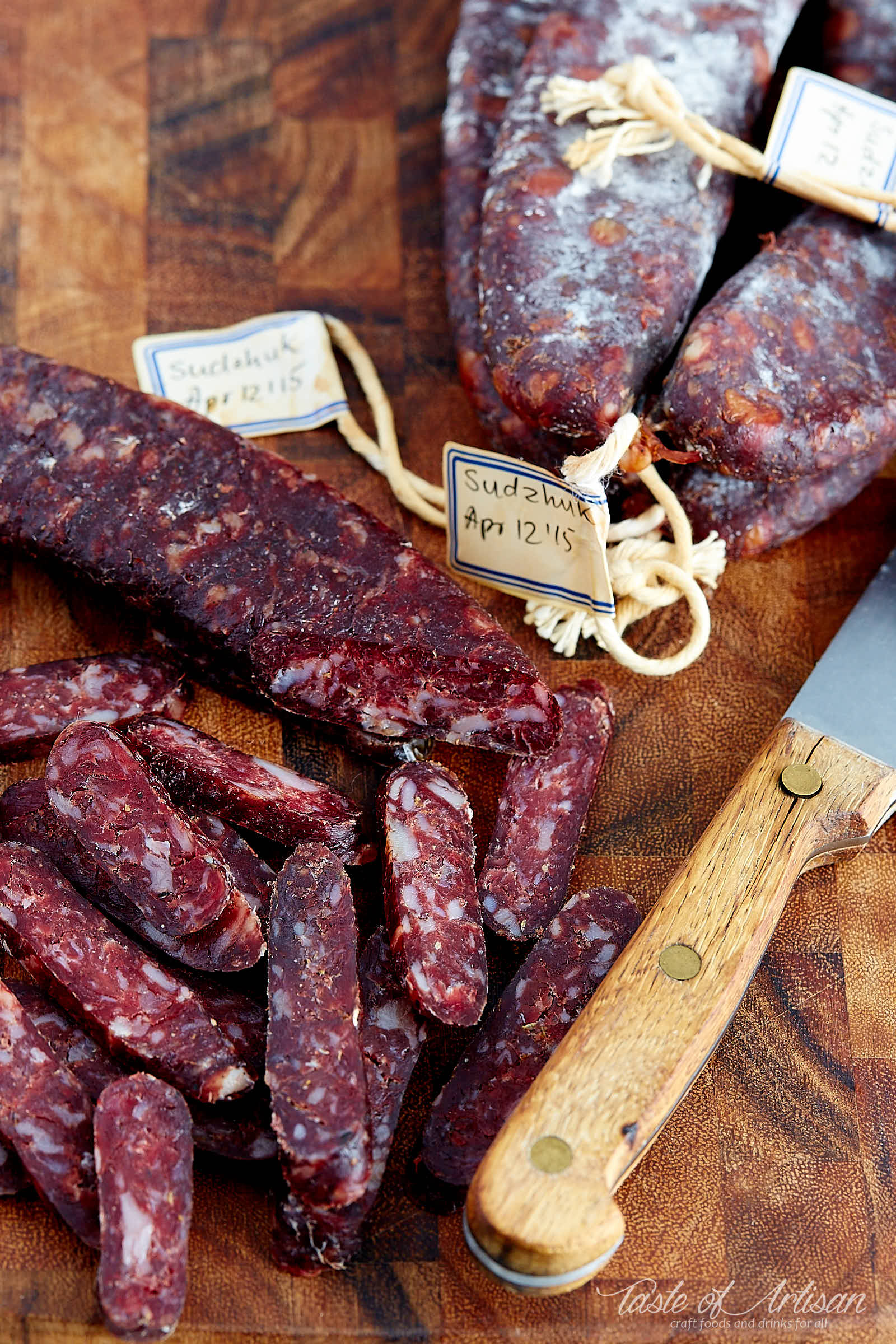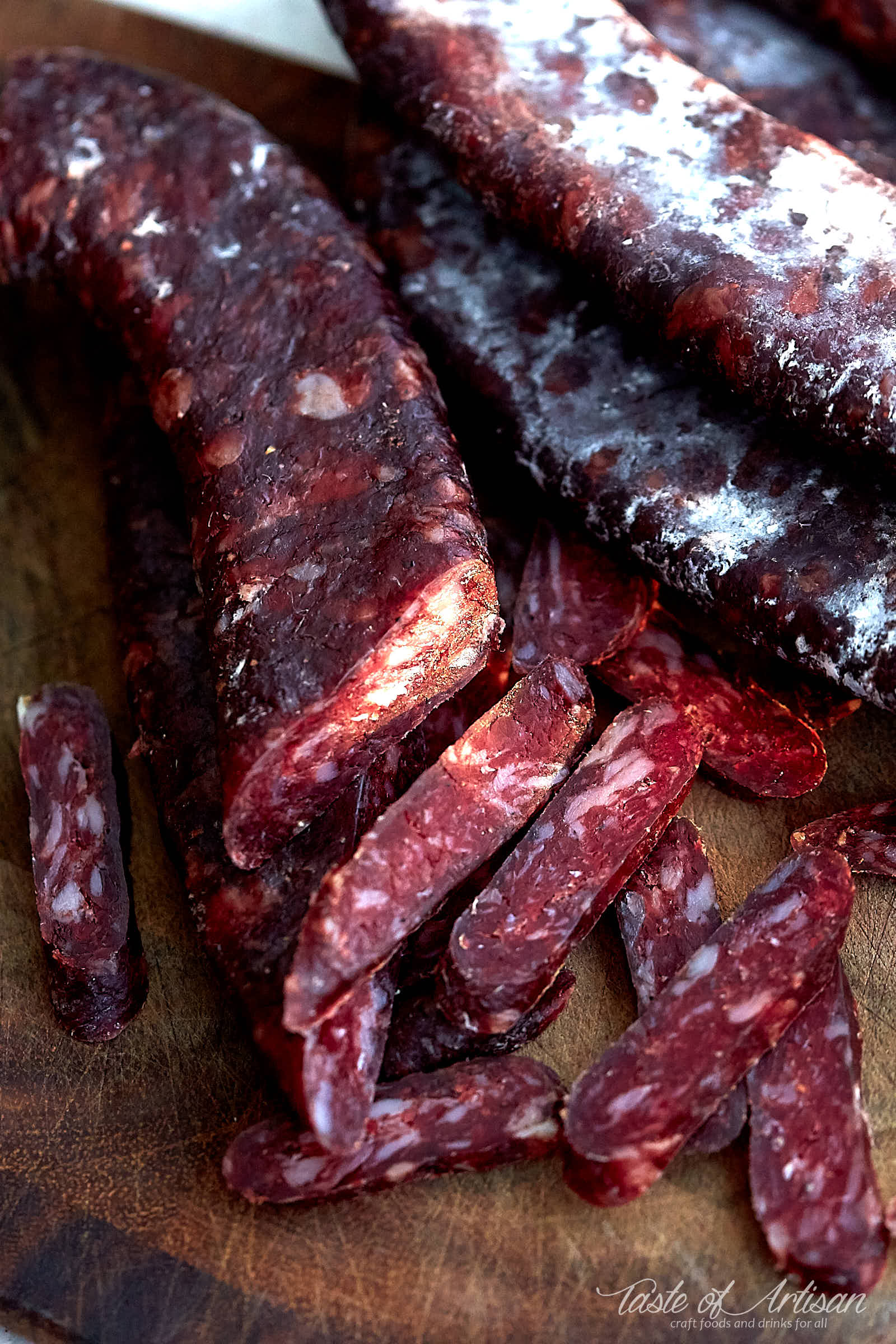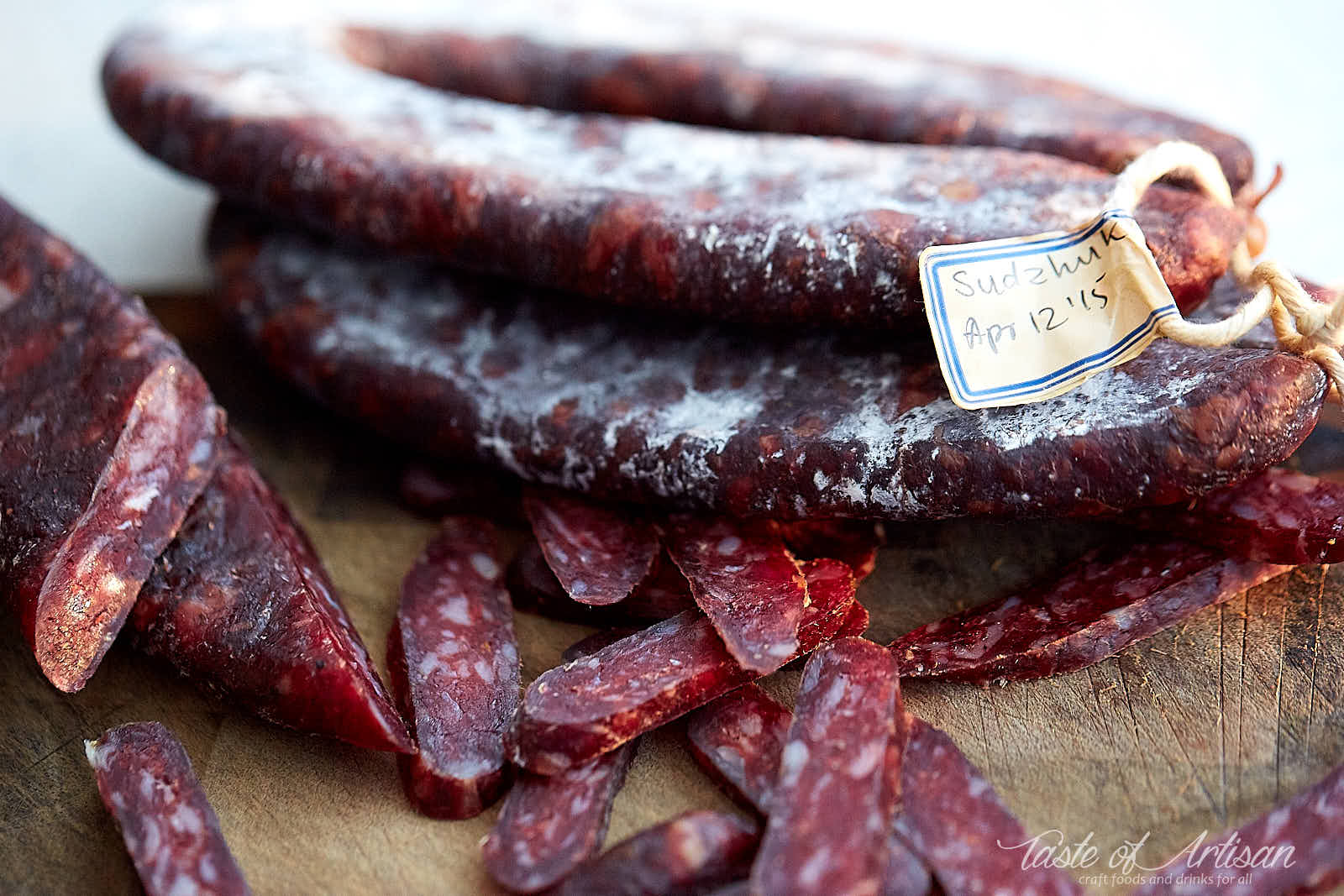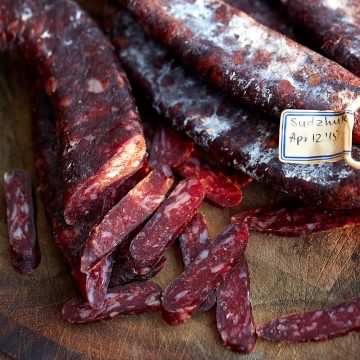There are hundreds of various types of dry-cured sausages out there but there is one kind that I am especially fond of. It's called sujuk. Some other common spelling forms of this sausage are sudzhuk, sucuk or soujouk, depending on the country it originates from.

What is sujuk?
I was fortunate to taste the authentic Gornooryahovski and many other varieties of sujuk while traveling Eastern Europe a few years ago. Sujuk has a clean, noticeably tangy, beefy taste not overpowered by spices. Fairly hard and dry, sujuk reminded me of good beef jerky but it was less chewy and more fatty compared to jerky. Spices vary depending on the variety and location. In general, I'd say of all cured sausages it became one of my favorite.
Over here good sujuk is almost impossible to find. What I could find was a remote resemblance of the real thing that did not excite me at all. This forced me to venture into the unfamiliar territory of sujuk making. Luckily, I was able to find this official publication online that gives a very good idea about how to make dry cured sujuk. I used it as the base for making my own.

Characteristics of Sujuk
According to the publication, Gornooryahovski Sudzhuk is a compacted, non-perishable, raw, dried sausage manufactured from natural gut filled with machine-minced beef. The surface is evenly coated with a dry, white, powdery sausage mold. The sausage is cylindrical, flattened and bent into a horseshoe shape. Its ends are tied off and bound together with string. It is 35-40 cm in length and up to 40 mm in diameter. It is solid, elastic and has the same consistency at the periphery as it does at the core. The cross-section is elliptical with an even, fine-grained texture on its surface.
The meat filling is free of cavities, sinews or fasciae. The filling is marbled, its color varying from red to dark brown as is typical for beef. The fat is white in color. There is no dark-colored peripheral ring or grey discoloration in the interior of the cross-section. The flavor is distinctive, pleasant, spicy, moderately salty and free from any extraneous taste. The aroma is distinctive, with vivid tones reflecting its specific mixture of herbal seasoning (black pepper, cumin and savory).
Physical and chemical characteristics: water content does not exceed 45 % of the overall mass; fat content in dry matter does not exceed 65 %; kitchen salt does not exceed 4.5 % of the overall mass; nitrites do not exceed 50 mg per kg; pH ≤ 6 and ≥ 5.1; and aW ≤ 0.88.

Making sujuk
I am not big on using cumin unless I am making chili or pilaf. Savory? Maybe. I do like a little bit of garlic and onion powder in my beef sausages though. I made the substitution and loved the results. Either way is great, it's just a matter of preference.
If you have the opportunity to cold smoke sujuk for about 12-24 hours, it's definitely worth it. It can be done either during fermentation or drying as long as the temperature and humidity conditions are met. While this is definitely against the official guidelines, the smoky flavor takes sujuk to the next level. Additionally, smoking provides some antimicrobial (phenols and acids) and antioxidant (phenols) properties to the product. That said, keep in mind that these must be considered as an additional safety hurdle and not the main one.
Using a starter culture
Traditionally sujuk is made without the use of starter cultures as microbiological safety is achieved by drying and not by increasing acidity. This is fine when meat is handled properly, without the risk of cross-contamination, and the maker can ensure that the sausage has dried properly. As an enthusiastic sausage maker, I feel that it's better to be safe than sorry. FLC or B-LC-007 cultures will work well for this recipe.
I add 0.3% of sugar to the mix to achieve a pH of slightly higher then 5.0. This is within the spec of Gornooryahovski Sudzhuk. You can increase the amount of sugar to 0.5% for slightly more tang.
Interestingly, here is the study that demonstrated a positive effect on color, texture, and taste in the production of Turkish sucuk - all are good reasons to use a starter culture.
My curing chamber - Advanced Meat Curing Chamber.

Homemade Sujuk
Ingredients
- 1000 g beef chuck
- 26 g kosher salt
- 2.5 g Cure #2
- 2 g freshly ground black pepper
- 1.5 g freshly ground coriander
- 1.5 g garlic powder
- 3 g onion powder
- 0.2 g T-SPX starter culture ( activated in 60 ml distilled water)
- 3 g sugar or a 50/50 combination of dextrose and sugar
Instructions
- Partially freeze the beef before processing to make sure it stays cold.
- Cut the meat into 100-150 g pieces, remove sinew. Grind through a medium size plate (3/16" or 4.5 mm).
- Mix the ground meat, spices, sugar, and the starter culture. Stuff into 28-32mm hog casings, making 18" (45 cm) links, and tie with twine.
- Ferment at 71-77F (22-25C), 85-100% RH for about 48 hours in an area with good ventilation, until the meat firms up and turns dark red.
- Dry cure at 55-57F and 70-75% RH for about 30-45 days until a target weight loss of about 55% is achieved.
- Starting on day two of the drying stage, flatten the sujuk by gently rolling it with a roller. Do not press too hard otherwise the casings may burst. Continue doing this once a day for about 4-5 days.
- Optionally, you may smoke sujuk for 12-24 hours during fermentation or drying, ensuring temperature and humidity conditions above are met, to obtain smoky flavor.
Nutrition
This post was updated on September 5, 2023


Gintaras says
Hi Victor.
I see that in the recipe you write sugar and and then it says dextrose. May I ask if you meant to add sugar by the dextrose? Don't want to be picky but I do smoked sausages only so want to make sure I make sujuk right. As on Mariansky web site whe adds and sugar and dextrose to some of the dried sausages.
Many thanks,
Gintaras
Victor @ Taste of Artisan says
Hi Gintaras, I've been testing and modifying this recipe and it looks like I forgot to change dextrose to sugar in the instructions. Fixed now.
P.S. Sucrose is fine to use with T-SPX in this recipe, I actually prefer it to dextrose or dextrose/sucrose combo, but you can use a combination of sucrose/dextrose which will give you a slightly faster upfront acidification and, IMHO, a tangier taste overall.
Gintaras says
Thank you for your reply.
Victor @ Taste of Artisan says
You are very welcome. Good luck!
Tim says
I'm really keen to make this but in your picture the sujuk appears to have bits of white fat although it isn't mentioned in the recipe. Did you use pork fat in this at all?
Victor @ Taste of Artisan says
Coincidentally, I just made a 10-lb batch of sujuk 3 days ago and it's just finished fermentation. I updated the recipe slightly to reflect some minor changes I've made to it.
https://tasteofartisan.com/wp-content/uploads/2022/10/sujuk-2022.jpg
As far as fat goes, chuck is not a lean piece of meat. I may trim some of fat off, but mostly I grind it with meat so that's why you see bits of fat. I estimate there are about 25% of fat there, maybe 30% if it's a fattier piece.
I never add pork fat to sujuk.
Jesse says
Hello,
This looks great! I've made a similar cold smoked and dried Texas-style sausage (Venison & Pork) with cure #2 but no starter culture or sugar/dextrose. Took about 15 days in 55-60 dark basement and turned out great, like a jerky. Think this would work without the starter culture and just add equivalent of fine white sugar instead of Dextrose? It's a pain to get culture where I'm at but thought a beef/venison might be worth trying. Thanks!
Victor @ Taste of Artisan says
Hi Jesse, I've made this without a starter at my own risk several times, like they did in the old times, and the results were great. Using a starter culture ensures that you get consistent results, get the acidity down to the proper level that acts as a hurdle against pathogenic bacteria taking over. Perhaps a more tangy taste. Lactic acid bacteria on the meat may be sufficient but there is a risk of things going the wrong way too. So, best to use a culture for safety reasons and predictable, consistent results. Not using it won't make the sausage bad, and that's how it was made for centuries, but you are taking some risks there.
Rob says
I made this a few months ago along with coppa and other salamis, and the Sujuk disappeared first! That surprised me since it's a little like jerky, which takes awhile to disappear in my house, but I liked the Sujuk a lot better. I smoked mine with an AMNPS on a maiden run, and got a lot of white billowing smoke, so I went with 6 hrs instead of 12-24 hrs smoking time. It was VERY smoky in flavor - which I learned to like. I'm making my second batch right now, and decided to add cumin to 1/2 the batch (at a 5g per 5 lb rate), keeping all other ingredients the same. I'll let you know how it turns out. Thanks for the recipe Victor, I really enjoyed it.
Victor @ Taste of Artisan says
Glad to hear it, Rob. My family loves it. It does remind of jerky in a way, fatty jerky to be specific which we all love. I don't know if you've heard of this place called Big John's Beef Jerky. I've been hooked on it since around 2007, no jerky comes even close. Not all flavors, but some are fantastic. A few years back they started selling fatty jerky. When you make an order, you have to specify that you want fatty and they will accommodate. It's the same jerky only made with fattier, more marbled meat. To me, it's way better than regular jerky, tastier and easier on your teeth. That's all I order from them lately - fatty jerky of my favorite flavors. Highly recommend. I've been thinking of replicating it. I've seen many pictures of their production process so I have an idea. Now that I have a well-behaving smokehouse it won't be a problem.
Elmar Bagir says
Hi, I never argue about recipes, you are right there are many variations, so there is no right or wrong. My comment is about curing salt. Your whole process takes about 3 weeks, so I guess cure #1 should be fine. Cure #2 is for over 30 days dry curing. Eastern
Victor @ Taste of Artisan says
You are correct, nowadays fast and medium-fast fermenting sausages are made with nitrites (Cure #1). Drying time varies, sometimes it takes longer. I feel more comfortable using Cure #2 in this recipe, but that's just me.
Matt says
Can you tell me how much this is of the sugar that you are adding, the % I do not understand
I add 0.3% of sugar to the mix to achieve a pH of slightly higher then 5.0. This is within the spec of Gornooryahovski Sudzhuk. You can increase the amount of sugar to 0.5% for slightly more tang.
greg says
Where can you buy thses products
Victor @ Taste of Artisan says
Where are you located?
ET says
This really looks delicious. I have finocchiona that is drying now once that’s all done this will be next baby.
Victor @ Taste of Artisan says
Thanks. My kids have been asking for it for months but I have a similar problem - not enough space in the curing fridge;) By the way, I a huge fan of finocchiona. Made it last fall and cold smoked for 24 hours. Dried for 3 1/2 months before cutting for Christmas. My guests couldn't have enough of it. Superb flavors and it cured really well. Will be making again this year for sure.
Rhancha Trick says
Hi there! I want to make this but where would I purchase Cure #2 and the starter culture? We just visited Bulgaria and ate a lot of this 😊 we want to make our own. Thanks for your help!
Victor says
I know, that's what happened to me. And I couldn't bring any with me.
There a few good places to buy from: e.g. http://www.sausagemaker.com, http://www.butcher-packer.com. I like them both.
Chris says
Amazing .... THANKS FOR SHARING
victor says
Steve, the 12-24 hour smoking recommendation comes right from the publication. They don't specify how exactly they do it. I'd say, if you are blowing thick, white smoke and feel like 2-3 hours gives you plenty of smoky flavor, then that's what you should do. I think when they say 12-24 hours they mean light think smoke that you'd see circulating in big industrial smoke rooms.
paul says
I made this no fermentation i just dried cured.... Oh my god it was and is FANTASTIC
victor says
😉 I know what you mean, Paul. My kids are crazy about this sujuk. I make a few pounds every two-three months.
Matt says
I’m looking to do the same, just dry curing , but would like some input as to what all you did or didn’t do, I assume because of the #2 the slow dry cure was what you did, and did you smoke it or cold smoke it?
Todor says
Hey Victor,
I am going to try the recipe.
Great blog! Amazing results!
Keep it up!
victor says
Thanks for the kind words, Todor. Good luck making your Sujuk.
Scott says
First I want to say thanks for your site. As a tinkerer and foodie myself I found the information here about your curing chamber invaluable in designing and building mine. Yesterday I made your recipe and have it fermenting currently as I type this. I do however want to know if you know the amounts of savory and cumin from the original recipe.
Thanks
victor says
You are very welcome. The official publication does not specify the amounts (I posted the link in the post above), however you can try this recipe:
Meats Metric US
Beef 70/30 lean/fat) 1000 g 2.2 lb
Ingredients per 1000g (1 kg) of meat
Salt 30 g 5 tsp
Cure #2 3.0 g 1/2 tsp
Sugar 5.0 g 1 tsp
Pepper 3.0 g 1-1/2 tsp
Cumin 2.0 g 1 tsp
Savory, rubbed 1 Tbsp
Starter culture, T-SPX 0.12 g use scale
Instructions
Grind meat through 1/4” (6 mm) plate.
30 minutes before mixing dissolve starter culture in 1 tablespoon de-chlorinated water.
Mix ground meat with salt, sugar, cure #2, culture and spices.
Stuff into 40 mm beef casings. Make links about 18” (45 cm) long, tie off the ends together making a loop.
Ferment at 20º C (68º F) for 72 hours, 90 → 85% humidity.
Dry at 18-15º C (64-59º F), 85→75% decreasing humidity for 20 days. The sausages are compacted once or twice with metal presses arranged on wooden boards. During the drying process, the surface of the sausages acquires an even coating of white mold which grows naturally in the room.
Store sausages at 10-15º C (50-59º F), <75% humidity.
Notes
Savory is a strong pepper flavored herb which can be found almost everywhere. It plays an important role in Bulgarian cuisine where it is known as chubritsa. You can substitute with thyme which is stronger. Or, combine thyme with a pinch of sage or mint.
Bill Tobias says
I made this recipe to the T and cured in a contrilled chamber. Product turned out great except a smell of "old dirty socks". Could this be due to the use of the starter culture. I plan on cold smoking tomorrow for about 6 hours to bump upmflavors
victor says
LOL... you know I heard someone say that good aged French cheese should smell like old dirty socks. That's a sign of quality. Now, what you are describing is the smell coming from indigenous molds that developed on the surface of your sasusage. This is totally normal as long as those molds are white. If you want to have control over what type of mold develops on the outside of the sausage, you need to use something like Bactoferm 600 (commercially cultured white mold), or make a starter culture from white mold collected from store-bought sausage. You need a small piece of the moldy casing, about 1x1 inch or a little bigger.
Victor @ Taste of Artisan says
An update - not all green molds are bad. I noticed green powdery mold develop at humidity leaves of over 80%. You can read more about bad and green molds here.
Jessica Dobias Aries says
This is a staple sausage in Central Texas, where we have a large Eastern European and German influences. Your sausage looks amazing and very true to the stuff I grew up on as a proud Czech.
Bob kline says
HI Victor,
I had a question about the amount of Bactoferm in a recipe which I thought was this recipe, however, I was mistaken.
Sorry for the confusion, but as a novice, I'll chalk it up to my inexperience.
Thank you Sir for a GREAT site!
Bob
victor says
No problem. Good luck with your new hobby. It's extremely rewarding.
paul bernard says
Can you use elk meat instead of beef?
victor says
Technically yes, but I would be very, very reluctant to use game meat for dry curing because of a much higher risk of meat being contaminated. Then again,m I have no experience with dry curing game meat.
Angela says
Hi Victor,
I've never tried fermenting... can you describe the process in more detail, please? Also, where can I purchase the flc starter?
Thank you
victor says
Hi Angela, fermentation allows beneficial bacteria grow at a fast pace to prevent pathogenic bacteria from growing and taking over. During fermentation pH drops to about 5.3, creating acidic environment that inhibits growth of some pathogenic bacteria. It's biggest benefit is a health safety, but there are other benefits as well. Acidity provides that nice tang that we all like in fermented sausages. Some cultures promote development of great flavor and color. I would suggest reading Marianski's Home Production of Quality Meats and Sausages book to understand all the basics of making fermented sausage and do it safely. The Art of Making Fermented Sausages is another very good book of his that is a must read for anyone trying to make dry cured products at home.
As to where to buy FLC, and many other cultures, the best place for most people is online. The Sausage Maker is where I buy since I live close by. Butcher & Packer is another popular online store.
petro says
hi Victor, I have tried to make it a couple times with a slightly different recipe, but was like a blind man during the night trying to find the right way to make sujuk. Couple times I was successful, couple times not really, but now I found a good guideline. The only difference between your recipe and mine is pure canadian elk and moose plus pork. I will keep you informed. Making a batch right now. Thank you
Victor @ Taste of Artisan says
Good luck, Petro. I hope it turns out great for you. If you want to share some pictures, let me know.